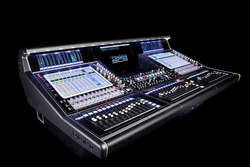DiGiCo at ProLight + Sound 2012
posted:
It has five digitally driven full color TFT LCD screens, three of which are touch sensitive, and the screens have a new configuration that allows easy access to single or multiple users. There are also two interactive dynamic metering displays (IDM) and quick access buttons are positioned down the left side of the channel screens for fast and easy navigation.
Incorporating the master screen into the work surface design has allowed for complete user feedback, but maintained a lower profile meter bridge. This still allows clear visibility of those on stage for the user, with everything in close reach to the mix position.
The SD5 comes with a 2Gb fibre optic system, which is capable of running 448 channels of I/O at 96kHz, plus 56 console-to-console tie lines, allowing connection to up to 14 of the SD variant racks. There are three redundant MADI ports and local I/O includes eight microphone inputs, eight line outputs and eight AES I/O (mono).
The SD5 has 124 input channels; 56 configurable busses, plus up to 5.1 master; a 24 x 24 fixed matrix; DiGiTubes on every channel, buss and output; 24 assignable Dynamic EQ; 24 multiband compressors; 24 stereo effects; 32 Graphic EQ; 10 x 4 (40) RGB backlit macro buttons; plus the ability to add a Waves upgrade.
advertisment
"The SD5 has some DiGiCo added extras as well," adds Gordon. "The D5 Live was the first ever console to have an integrated light bar, so of course, the SD5 has that as well. We've also included keyboard illumination and convenient headphone hooks to save you having to borrow a drumstick to hang up your headphones.
"The D5 was at the forefront of the live world moving over to digital mixing and SD5 is the perfect way of taking that pioneering spirit to the next level."
The PL+S show has also brought with it a series of DiGiCo SD series software and firmware upgrades that are free to existing customers, and to new customers who purchased an SD console before ProLight+Sound 2012.
• The SD11 is designed to be used as a desktop console or mounted in a 19” rack. Its software/firmware upgrade converts it to the SD11i with more Flexi-channels, more Dynamic EQ, for FX processing and the addition of DiGiTubes and Multichannel inputs (previously only available on the SD7).
• The “Supercharged” software and firmware upgrades for the SD9 supply an expansion in Channel count, Dynamic EQs, Multiband Compressors and Matrix with the addition of DiGiTuBes, Reorder of Busses and Multichannel inputs (formerly only available on SD7). The company claims this gives the SD9 “more features and functionality than any other console in its class.”
advertisment
• The new “Overdrive 2” upgrade for the SD8 provides the entry-level console with up to 60 stereo inputs (equivalent to 120 flexi channels of DSP), 24 flexi busses (stereo or mono) plus two solo busses and master, four band parametric EQ (with dynamic EQ on up to eight channels), hi/lo pass filters and dynamics on all inputs and outputs, 24 graphic EQs, eight stereo effects, and a 16 x 12 matrix. And, when fitted with the optical option, the SD8 can have up to four racks connected to it, providing up to 240 I/O.
• The SD10’s “Nitrous” upgrade provides expansion in the amount of Dynamic EQ, Multiband Compressors and FX, plus the matrix increasing from a 16 x 12 to 16 x 16 and the addition of DiGiTuBes, Reorder of Busses and Multichannel inputs.
• The final upgrade is “Mach3” for the flagship SD7, which incorporates all the new features found in the upgraded SD range, plus some added extras that are exclusive to the SD7.
The console world has clearly moved toward a platform-based digital architecture, and these new product announcements stand as clear evidence that customers are getting a lot more bang for their buck in today’s market. DiGiCo will be showing the new console also at the upcoming NAB Show.




